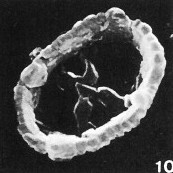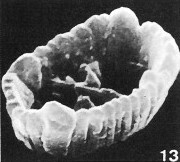Davidhakania eosaepes
Set number: 1880
-
1
-
2
-
3
-
4
-
5
-
6
-
7
-
8
-
9
-
10
-
11
-
12
-
13
-
14
-
15
-
16
-
17
-
18
-
19
-
20
-
21
-
22
10µm
In the mobile mount
Neochiastozygus eosaepes Perch-Nielsen, 1981
This species is characterised by an asymmetrical diagonal crossbar with an acute angle aligned along the long axis. The longer arm is inclined more than 20° counterclockwise relative to the long axis of the discolith on the distal side. The optical properties are consistent with those of the genus Davidhakania. This species displays extinction lines with a typical extinction angle of approximately 74° on the distal side and exhibits length-fast (−) elongation.
Davidhakania eosaepes differs from Davidhakania imbriei in the alignment of the longer arm of the crossbar. In Davidhakania eosaepes, the longer arm is inclined more than 20° counterclockwise relative to the long axis of the discolith on the distal side, whereas, in Davidhakania imbriei, it is inclined less than 20°. Davidhakania eosaepes is further distinguished by its asymmetrical crossbar, whereas Davidhakania saepes and Davidhakania partingtonii possess symmetrical crossbars.
Perch-Nielsen, K., 1981b. New Maastrichtian and Paleocene calcareous nannofossils from Africa, Denmark, and USA and the Atlantic, and some Paleocene lineages. Eclogae Geologicae Helvetiae 74(3), 831-863.
Varol, O. 2025a. A practical guide to optical studies of calcareous nannofossils. Grzybowski Foundation Special Publication. 29: 1-222

